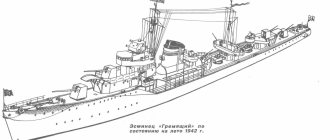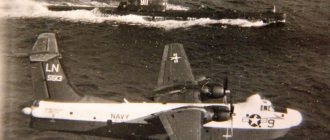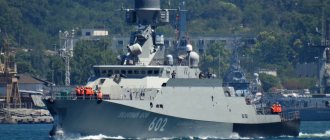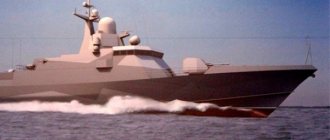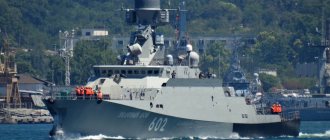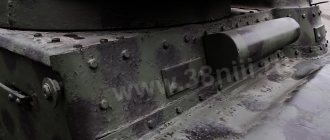Home » Alternative shipbuilding - Fleets that never existed » “Pocket” small destroyer/SKR from BO project 122, 122A
Alternative shipbuilding - Fleets that never existedAlternative shipbuilding - Fleets that never existed
napoleon_6 01/14/2019 3585
11
in Favoritesin Favoritesfrom Favorites 9
Part 1. The real story.
By the beginning of the Great Patriotic War, the ships laid down at one of the Volga shipyards were built and in the fall of 1941, the famous Soviet boat, subsequently Rear Admiral B.V. Nikitin received an order to accept several large hunters to include them in the Caspian military flotilla. Arriving in Baku, Nikitin saw these ships at the pier - with narrow steel hulls, the bows of which were raised, which made them look like small destroyers. The selection committee was faced with the problem of using large hunters, since during the war, transferring them to the Baltic and White Sea became impossible. It was decided to turn the hunters into guard ships for the tanker fleet in the Caspian Sea. Since the main enemy here were fascist planes, and the weapons of large hunters were ineffective against them, the depth charges were removed from the boats, and the artillery armament was reinforced with a 37-mm anti-aircraft machine gun and another heavy machine gun. By the end of December 1941, all boats were transferred to the Caspian Flotilla. In the following months, they accompanied tankers with liquid fuel in the Caspian Sea and Volga, and participated in the battles of Stalingrad as part of the Volga Flotilla.
Displacement 240 tons. Maximum length 49 m, width 5.8 m, average depth 2 m.
The total power of three domestic diesel engines of the 38-NRN-8 type or American General Motors is 3360 and 3600 hp. With. accordingly, the speed is 24-25 knots.
Armament: one 76-mm 34-K gun (later 85-mm 90-K), two 37-mm 70-K machine guns, two coaxial 12.7-mm machine guns, two bomb launchers, 18 large and 16 small depth charges.
The “Big Hunter”, as a type of small anti-submarine ship (the concept was formulated back in the 20s - “submarine finder”), was created in the USSR on the eve of the Great Patriotic War. In those years, taking into account the growing role of submarine forces in armed warfare at sea and the need to strengthen and improve anti-submarine defense forces and means, the leadership of the USSR Navy decided to create a new subclass of warships - large submarine hunters.
The main task assigned to these ships was to perform patrol and security service in the near zone of our naval bases and along the routes of deployment of fleet forces. It was assumed that it would be a fairly seaworthy and fast ship, with an increased cruising range, of small displacement, which would be capable of carrying weapons that were modern at that time to combat submarines.
Design Bureau of the Baltic Shipyard in 1938-1939. developed a project for a maritime border guard ship No. 115. The leadership of the People's Commissariat of the Navy, interested in such a ship, instructed the design bureau in Gorky (TsKB-51) to rework it and retrofit it with a Tamir-type hydroacoustic station. The new project received No. 122. Zelenodolsk plant No. 340 and plant No. 300 (“Lenin Forge”) in Kyiv from 1939-40. began the construction of a series of large hunters (6 and 4 units, respectively). In parallel with the construction, adjustments to the design were carried out at TsKB-51. "Artillerist", the lead large hunter of plant No. 340, launched on April 21, 1940, and after it in the same year, at the same plant, the second, "Miner", was launched.
The adjusted Project 122-a provided for arming the ship with one 76-mm 34-K universal artillery mount, three 12.7-mm DShK machine guns and depth charges (16 large and 40 small). The normal displacement according to the project was 209 tons, speed 23 knots, cruising range 2410 miles. The main mechanisms consisted of three 9D diesel engines with a power of 1100 hp each.
DRAWINGS ARE CLICKABLE
The construction of the first production ships of Project 122-a, which was delayed due to the finalization of the project before the start of hostilities, was not completed in time. The first two large hunters, “Artillerist” and “Miner,” were ready for delivery to the customer in July 1941. They were transferred along the Volga to Baku, where, after completion of acceptance tests, in November 1941 they entered service with the Red Banner Caspian Flotilla.
The first domestic underwater retractable hydroacoustic equipment “Tamir” was installed as a means of underwater observation. The three-shaft main power plant, consisting of 9D diesel engines from the Kolomna plant with a power of 1100 hp, allowed a speed of up to 22 knots. and provided a navigation area of up to 2000 miles.
However, during the tests of the lead ship “Artillerist”, built by Zelenodolsk plant No. 340, in the autumn of 1941 on the Caspian Sea, serious shortcomings were also revealed. Thus, there was no low-noise mode (2-4 knots) for listening to the noise of submarines. The engine of the American company General Motors with a power of 90 hp, installed for the low search speed mode, did not provide controllability of the ship. The Poseidon noise direction finder, even when the ship was drifting, did not provide reliable detection of submarines. They also revealed insufficient overall strength of the ship's welded hull (a crack appeared in the outer plating on the starboard side). This required corps reinforcements.
Finalization of project No. 122-a at TsKB-51 under the leadership of N.G. Loschinsky included the strengthening of weapons: the installation of an 85-mm 90-K gun instead of a 76-mm 34-K (out of production), two 70-K machine guns and two bomb throwers, the placement of a sonar station of the Tamir-3 type and the replacement of domestic diesel engines of the 9D type imported American ones from General Motors. All these changes led to a decrease in the initial transverse metacentric height from 0.51 to 0.43 m. A special commission chaired by Yu.A. Shimansky, with the participation of A.N. Krylov and V.L. Pozdyunin, established the minimum permissible value of the metacentric height of at least 0.47 m.
The modified Project 122-a, with some changes, was accepted for ships of factories No. 340 and No. 199, as well as for those newly laid down in 1941-1942. at plant No. 402 in Molotovsk and at the Vladivostok shipyard of Narkomrybprom. At plant No. 402, in particular, they switched from welded plating to riveted plating, which increased the weight of the hull by 7 tons. In terms of their shipbuilding elements, domestic ships of Project 122-a were not inferior to the American hunters of the PC and PCS types supplied to our fleet under Lend-Lease, were somewhat superior to them in artillery weapons and inferior to them in the sophistication of radar and hydroacoustics.
Supplies of General Motors diesel engines from the USA made it possible to replace domestic engines with foreign ones. The documentation for the conversion was developed by TsKB-51. This is how the second series of project 122-a BOs with American engines appeared.
In the interests of the speedy deployment of large-scale production of large hunters, the leadership of the People's Commissariat of the Navy abandoned Project 152, developed in 1942-1943. in TsKB-51. The main difference between the large hunter of this project was the strengthening of the armament to two 85-mm guns, increasing the hull width to 6.2 m and reducing the speed to 20.5 knots (note - Here is the artillery version!)
Part III American hunters for submarines of the RS and SC types
Part III American hunters for submarines of the RS and SC types
Large hunter of American construction type SC as part of the USSR Navy. Pacific Fleet, Sovetskaya Gavan. 1951
In 1937, the US Navy announced a competition for the best design of large and small submarine hunters, in which design teams from both the Bureau of Construction and Repair and private shipbuilding firms took part.
The project of the representative of the Shipbuilding Department, Captain A.L., was recognized as the best. Swossey. His hunter “SC-453” (SC - Submarine Chaser) was adopted as a model for the construction of one of the largest series of warships during the Second World War. The new ship was superior to its prototype, the “110-foot hunter” of the First World War, in width and had a significantly greater displacement - 136 tons, at full load instead of 85 tons. The main power plant of two aviation (airship) diesel engines of the “pancake” type with a power of 1200 hp each each provided speeds of up to 22 knots instead of 18 for the old hunters. However, difficulties with the mass supply of these diesel engines led to the fact that more than half of all SCs built (231 out of 438 units) had to be equipped with two 500 hp diesel engines. s, which allowed it to reach speeds of up to 16 knots, which was less than the surface speed of most submarines of that period.
The new hunter was also made in a wooden body, which was reinforced in the middle part with steel elements to ensure the installation of diesel engines. Flatter contours of the stern end made it possible to reduce water resistance at high speeds.
The ship's gun armament initially included one light but versatile gun mount with a 76mm gun measuring just 23 calibers in length, although World War II submarines were armed with guns with much higher ballistic qualities. In this regard, already in 1943, a different composition of artillery weapons was adopted: one 76-mm universal deck artillery mount with a 50-caliber gun and three 20-mm Oerlikon machine guns. However, the very next year the 76-mm artillery mount was replaced by a 40-mm Bofors anti-aircraft machine gun, which had a much higher fire performance.
At the same time as the artillery, the hunters' anti-submarine weapons were also strengthened. In 1942, in the USA, based on the image of the English rod bomb launcher "Hedgehog" ("Hedgehog"), they developed a lightweight jet bomb launcher "Mousetrap" ("Mousetrap") especially for small anti-submarine ships and boats. This bomb launcher was extremely simple in its design - four jet depth charges weighing 39 kg each were placed on a stationary folding steel frame of the launcher and fired in a salvo at a distance of up to 300 m. The dispersion of bombs in a salvo reached 75 m. The explosion occurred when the impact contact fuse of one from bombs only if it hits the submarine hull directly.
It was very difficult and unsafe to install heavy bombs on the launcher frame during intense rocking of a small ship or boat. Therefore, they were replaced with smaller ones, weighing 29.5 kg, containing 16 kg of Torpex-type explosives. With the help of the very imperfect “Mousetrap”, not a single submarine was sunk during the entire war. Nevertheless, the “SC” type hunters, with their fairly good seaworthiness, although they did not become an effective anti-submarine weapon in terms of the number of submarines sunk, did make it possible to significantly reduce shipping losses off the Atlantic coast of the United States, in the Gulf of Mexico, etc. during tense months for the allies 1942-43.
Post-war period (project 122 bis)
I will not dwell on the details of pr. 122 bis. In the technical project 122-bis, by increasing the width and reducing the speed, it was possible to increase the strength of the hull, seaworthiness from 6-7 to 9 points and slightly strengthen the armament. At the same time, the design displacement increased by 27 tons.
In the first post-war decade, the construction of large hunters, which generally performed well during the war, continued. The ten-year plan planned to build in 1946-1955. 345 such ships. The organization of the construction of large hunters pr. 122 bis at the Gorky plant in Zelenodolsk was carried out using the flow-position method. This made it possible to deliver 25-30 ships to the fleet annually. Such a production line for the construction of ships was the first in the USSR.
Combat use
Baltika
The first, lead ships of the OKT-1 and OKT-2 series at the end of 1940 became part of the NKVD border guard of the Baltic District and began to be listed as PSKR 3rd rank. In January 1941, they were renamed “Topaz” and “Coral”, respectively, and on June 22, the 2nd Baltic detachment of border courts, on the basis of an order from the People's Commissar of the Navy, was transferred to the subordination of the Red Banner Baltic Fleet. Hunters became part of separate divisions of the basic TFR. Topaz's combat journey was short-lived: in August 1941, he died during the Tallinn crossing.
Caspian flotilla
By August 1942, the flotilla’s naval personnel were replenished with newly built warships that came from Zelenodolsk: “Artillerist”, “Miner” and “Torpedist”. Later it included: “Boatswain”, “Anti-Gunner”, “Range Finder”, “Projector Operator”, “Gunner” and “Flame Thrower”.
On October 27, 1942, the tanker “Agmaly ogly” (displacement 800 tons) delivered fuel from Baku to the Astrakhan roadstead. At this time, enemy planes flew in. One of the bombs hit the tanker's bridge, starting a fire. An unmanageable ship ran aground. At this critical moment, warships arrived to help the tanker in distress - the Artillery and Miner ships, and floating anti-aircraft batteries. They scattered enemy aircraft with the fire of their cannons and machine guns, destroying one bomber. Then the rescue of the tanker began, and “Artillerist” and “Miner” from October 29 to 31 guarded the damaged vessel and carried out work to refloat it.
A month later, on October 31, the Miner was on patrol in a twelve-foot roadstead. At 16.15 the signalman reported the appearance of seven Ju-88s. They walked from the direction of the setting sun, camouflaging themselves in its rays. The dropped bombs did not harm the ship, but one of the planes was shot down by machine gun fire.
On November 15, the artillery tanker, together with two floating anti-aircraft batteries, escorted the Kulibekov tanker; the latter was in tow with a dredger and two motorboats. Four Ju-88s attacked the tanker, which received serious damage from nearby bomb explosions and began to sink. "Artilleryman" came to the rescue. 43 people were rescued from the sinking ship. While repelling the air attack, two enemy aircraft were shot down.
Transfer of large hunters to the Black Sea.
During the Great Patriotic War, an operation was carried out to transport five large hunters of Project 122-a from one maritime theater (Caspian Sea and Lake Onega) to another (Black Sea). The entire operation to transfer the ships lasted from October 1943 to August 1944.
All ships arrived from Astrakhan and Vytegra to Sarepta near Stalingrad under their own power. Here, at plant No. 264 (the former Krasnoarmeyskaya shipyard), the slipway was converted, with the help of which the warheads were lifted ashore. According to preliminary calculations, their weight should not exceed 157 tons. During dismantling and unloading, artillery systems, all ammunition, smoke equipment, chemical equipment, anchor and anchor chains, mast, fuel, all supplies, etc. were removed from the ships. The launching of ships onto keel blocks was done manually using hemp ends. After being lifted ashore on three carts, the rudder and propellers were also removed from the ships. Additionally, calculations were carried out of the stresses during general bending in the body structures due to the action of the support reactions of the bogies, which did not exceed the permissible ones. After loading onto the conveyor, it was established that the actual weight of the BO (due to incomplete unloading) exceeded the calculated one and was in the range of 170-187 tons.
Then they were loaded onto 240-ton transporters and delivered by rail to Kalach-on-Don.
On the banks of the Don, a lowland was chosen, flooded in the spring, where a discharge dead end was laid, approaching directly to the water's edge. Artillery weapons were installed on the ships with the help of a railway crane and placed in February 1944, one after another, “in the wake” in the expectation that they would float to the surface during high water. However, contrary to the long-term forecast, there was little water that year due to insignificant precipitation and early snow melting. The ships did not surface until mid-April, and they had to be raised on pontoons converted from barges. Then the hunters were transferred in tow to Rostov-on-Don, where they were handed over to the Black Sea Fleet. The ships were already moving through the Sea of Azov and the Kerch Strait under their own power.
In the second way, BOs were delivered by special trains by rail directly to the city of Yeisk on the Sea of Azov. The duration of transportation was three days. To launch ships in the port of Yeisk in May-June 1944, a special launching device was built, located in the eastern part of the pier on the continuation of the access railway dead end of the grain pier. The launching of the ships without overloading was provided directly on the railway platforms, for which 110 m of railway track was laid in the water. In August the operation was successfully completed.
Black Sea Fleet
On July 1, 1944, at 5.00, the big hunters of the 2nd division (BO-102 “Miner”, BO-103 “Torpedist”, BO-101 “Artilleryman”, BO-104 “Anti-Gunner”, BO-105 “Boatswain”) left Yeisk to Taman. There they were joined by “Marsovy”, which also entered the 2nd Varna division of large hunters of the Black Sea Fleet.
On August 28, BO-103 and BO-106 guarded the base minesweepers during the transition from Novorossiysk to Sevastopol. The next day, these hunters, together with other ships of the detachment, left Sevastopol for Odessa, where they arrived on August 30 at 9.30. On the ships there were 331 sailors for the captured Romanian ships and 333 soldiers of the 393rd separate marine battalion. After a short rest and minor repairs, on September 1, the big hunters left Odessa for Tendra and from there to Constanta.
Northern Fleet
In the Northern Fleet, the big hunters of the 122nd project were engaged in everyday military work, and there was enough of it. There was no time to master new ships, the navigation area, or improve the bases, and this often affected military service. In connection with the intensification of hostilities by enemy submarines in the Arctic, the Northern Fleet command strengthened the defense of sea communications. The Yokanga and Kara naval bases were created, where several warheads were based. Now the ships were accompanied by special anti-submarine ships armed with sonar equipment and bomb throwers.
BO-150 "Motorist" entered the fleet on November 4, 1944, and on December 7 it was already involved in anti-submarine operations north of Kildin. BO-141 “Kirovets” was commissioned in mid-summer 1944, and in November it was escorting convoy YuV-5.
BO-142 On September 15, 1944, it took part in guarding convoy DV-2. But due to bad weather (wind 5-6 points, sea 3-4 points, cloudy, temperature +3°C) and malfunctions in the mechanisms, the ship, with the permission of the convoy commander, took a reverse course on September 16, to Dikson.
On December 29, BO-142 was guarding the minesweepers T-37 and T-32. The poor performance of the GAS led to the fact that the T-37 was torpedoed by a German submarine, which left the area with impunity.
On April 21, 1945, convoy PK-9 left the port of Liinahammari with an escort consisting of four destroyers, two Norwegian minesweepers, six large hunters and four torpedo boats. Despite the strong security, the enemy nevertheless launched several attacks with submarines 12 miles north of Cape Tsyp-Navolok. First, the destroyer “Zhestky”, together with the large hunter BO-131, attacked the detected submarine and thwarted its attack. Then, at about 7.00, the destroyer Derzkiy and BO-131 attacked another submarine with depth charges and began pursuing it. They bombed until the convoy passed the dangerous area.
Looking for a replacement
The Ministry of Defense has already made a fundamental decision to develop hunters based on the Project 22800 Karakurt MRC. Currently, as sources in the military department told Izvestia, tactical and technical data, the composition of weapons and equipment of the ships are being clarified.
Hunters will be able to operate in the coastal seas - the Baltic, Japanese, Black, Barents and Okhotsk, noted military expert Dmitry Boltenkov.
“The existing anti-submarine ships were built for the Soviet fleet,” he told Izvestia. “It’s time to think about what will replace them.” The Karakurt body as a basis for a future hunter is a good option. They are hardly noticeable to radar, as they are made using stealth technologies. Modern combat control, target designation and communications systems have been developed for them. The rework is unlikely to take long. Most likely, instead of Kalibr cruise missiles, they will install hydroacoustic equipment and anti-submarine weapons - rocket launchers for depth munitions and Package-NK complexes designed to combat enemy submarines and torpedoes.
Sea hunters protect naval bases and the near zone from diesel submarines and saboteurs, said former Chief of the Main Staff of the Navy, Admiral Valentin Selivanov.
“If hostilities start, they will have to clear these waters of the enemy,” the expert explained. “They also cover strategic missile submarines going on combat duty. The hunters will not give the opportunity to intercept our submarines near the bases, which will guarantee a retaliatory strike.
It is also important that the crews of the Karakurts of both modifications - missile and anti-submarine - can be trained according to the same program, of course, with the exception of specialists in cruise missiles and anti-submarine warfare. This will allow the fleet to save time and money, says Dmitry Boltenkov.
Type "Artilleryman" (project 122, 122a)
A total of 44 large hunters, Project 122-a, were laid down at four factories during the war years. and taking into account the 6 Zelenodolsk ships laid down before the war (four laid down at plant No. 300 were destroyed when leaving Kiev), the total number of ships of this project that began construction before the end of the war was 50. By January 1, 1946, 23 ships entered service. A detailed list of ships is here.
Project 122
Displacement 240 tons. Dimensions 49 x 5.8 x 2 m. Three-shaft diesel power plant, 3300 l. With. Speed 23.2/12.1 knots, range 1750 miles. Armament: 1 x 76/55 mm, 2 x 37 mm, 3 x 12.7 mm machine guns, 2 bomb releasers, 24 depth charges of the B-1 type or 48 M-1 type. Crew 49 people.
Project 122A
Displacement 244.2 tons. Dimensions 50.35 x 5.75 x 2.09 m. Diesel power plant, three-shaft, 3600 hp. Speed 21.3/11.3 knots, range 1900 miles. Armament: 1 x 76/55 mm, 2 x 37 mm, 2 x 12.7 mm machine guns, 2 BMB-1 bomb launchers.
